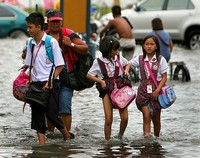Manila: 80 Percent of Capital Is Under Water
In the Philippines the death toll mounted. At least 103 are confirmed dead, the National Dusaster Coordinating Council said. Meanwhile the government said it’s struggling to cope with effects of flooding brought on by the heaviest rains in four decades. Two more storms formed east of the country.

The death toll doesn’t include those that haven"t been officially reported, Defense Secretary Gilbert Teodoro told reporters in Manila. While waters have been receding since the Tropical Storm Ketsana passed on Saturday, many remain in still-flooded areas.
"We really feel their anger and pain, but it is physically impossible to reach each and every one with the conditions that we face," Teodoro said, Bloomberg reports.
"The water is not moving," a tearful Nene Monfort, 71, told ABS-CBN television. She said she and her family were trapped on the second floor of their apartment and could not come down because of the water.
The disaster was the worst the capital had experienced in nearly half a century. Ketsana poured a month’s worth of rain onto Manila in just 12 hours, the government"s weather bureau said.
The Philippine government declared a "state of national calamity" in 27 provinces, The New York Times reports.
"Right now the challenge is to find out how many people have actually died and how many people we have to take care of in terms of people who've been displaced," said Richard Gordon, the chairman of the Philippines National Red Cross.
Officials worried that if the rains return, they could bring more floods if reservoirs burst.
Subscribe to Pravda.Ru Telegram channel, Facebook, RSS!


